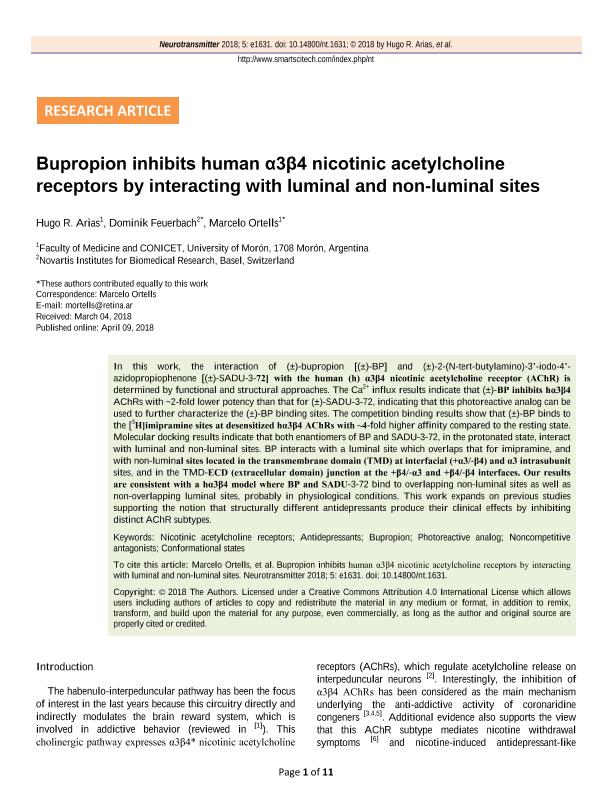Artículo
Bupropion inhibits human α3β4 nicotinic acetylcholine receptors by interacting with luminal and non-luminal sites
Fecha de publicación:
12/2017
Editorial:
Smart Science & Technology LLC
Revista:
Neurotransmitter
ISSN:
2375-2440
Idioma:
Inglés
Tipo de recurso:
Artículo publicado
Clasificación temática:
Resumen
In this work, the interaction of (±)-bupropion [(±)-BP] and (±)-2-(N-tert-butylamino)-3’-iodo-4’- azidopropiophenone [(±)-SADU-3-72] with the human (h) α3β4 nicotinic acetylcholine receptor (AChR) is determined by functional and structural approaches. The Ca2+ influx results indicate that (±)-BP inhibits hα3β4 AChRs with ~2-fold lower potency than that for (±)-SADU-3-72, indicating that this photoreactive analog can be used to further characterize the (±)-BP binding sites. The competition binding results show that (±)-BP binds to the [3 H]imipramine sites at desensitized hα3β4 AChRs with ~4-fold higher affinity compared to the resting state. Molecular docking results indicate that both enantiomers of BP and SADU-3-72, in the protonated state, interact with luminal and non-luminal sites. BP interacts with a luminal site which overlaps that for imipramine, and with non-luminal sites located in the transmembrane domain (TMD) at interfacial (+α3/-β4) and α3 intrasubunit sites, and in the TMD-ECD (extracellular domain) junction at the +β4/-α3 and +β4/-β4 interfaces. Our results are consistent with a hα3β4 model where BP and SADU-3-72 bind to overlapping non-luminal sites as well as non-overlapping luminal sites, probably in physiological conditions. This work expands on previous studies supporting the notion that structurally different antidepressants produce their clinical effects by inhibiting distinct AChR subtypes.
Palabras clave:
Nicotinic Receptor
,
Bupropion
,
Molecular Modeling
Archivos asociados
Licencia
Identificadores
Colecciones
Articulos(SEDE CENTRAL)
Articulos de SEDE CENTRAL
Articulos de SEDE CENTRAL
Citación
Arias, Hugo Rubén; Feuerbach, D; Ortells, Marcelo Oscar; Bupropion inhibits human α3β4 nicotinic acetylcholine receptors by interacting with luminal and non-luminal sites; Smart Science & Technology LLC; Neurotransmitter; 5; 12-2017; 1-11
Compartir
Altmétricas




